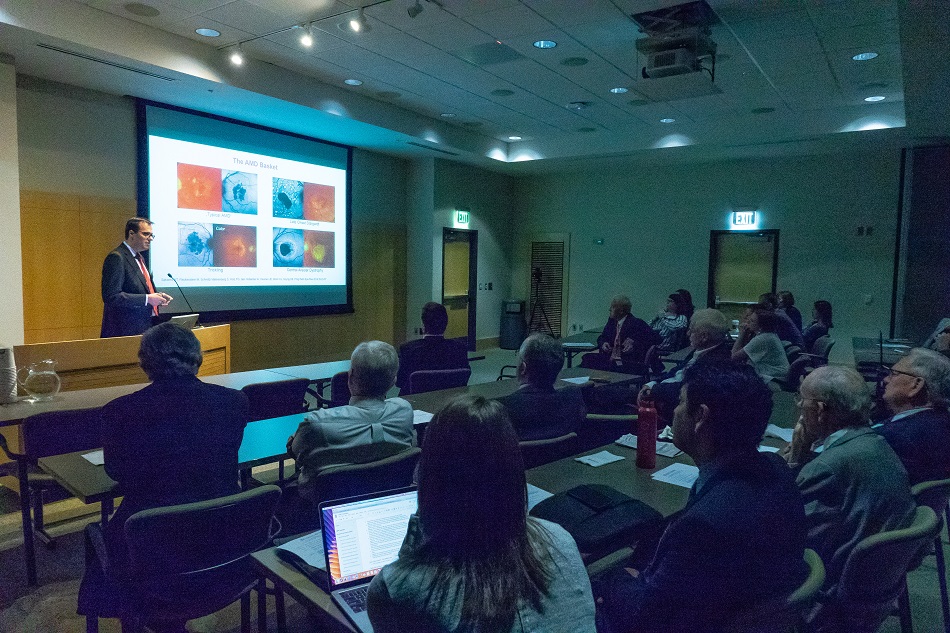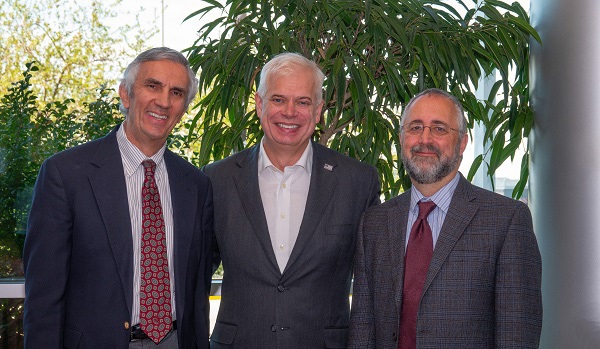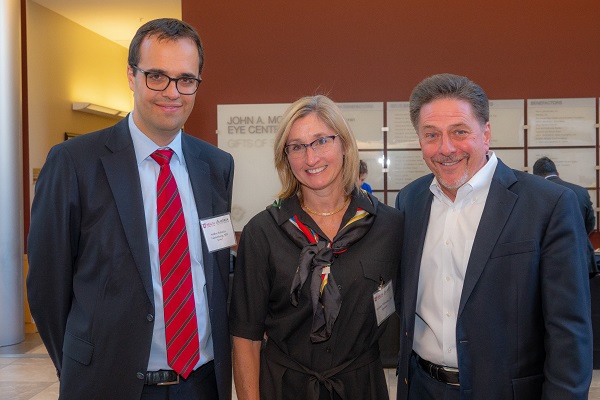
Leading researchers discussed the future of artificial intelligence (AI) systems in health care, telerobotic eye surgery, and diagnostic imaging at the John A. Moran Eye Center’s recent Translational Research Day.
Ten speakers from a variety of disciplines at the University of Utah and beyond presented a wide range of projects underway to turn scientific discoveries into clinically effective and cost-effective diagnostics.
Pioneering scientist, physician, and entrepreneur Michael D. Abramoff, MD, PhD, a professor at the University of Iowa, delivered the keynote address: "Autonomous AI in Healthcare: The First Steps."

Earlier this year, Abramoff received the first FDA approval for an autonomous diagnostic AI system, a revolutionary tool that can be used by primary care physicians to detect early stages of diabetic retinopathy. The condition, which occurs when high levels of blood sugar damage blood vessels inside the retina, is the leading cause of vision loss among millions of Americans with diabetes, many who do not regularly see an eye doctor.
With Abramoff’s device, called IDx-DR, a doctor uploads digital images of a patient’s retinas to a cloud server to be analyzed by an AI algorithm. If the software detects diabetic retinopathy, the patient will be referred to an eye specialist for treatment. Those with negative results will be referred for a re-screen in 12 months.
With early treatment, vision loss from diabetic retinopathy is almost entirely preventable. And since the device can make screening decisions autonomously, it can be used by health care providers in primary-care settings who are not typically involved in eye care, improving patient access with an affordable solution for a critical health care need.
Themes of technology and innovation continued throughout the Sept. 14 event, co-chaired by Moran’s Paul Bernstein, MD, PhD, and Nick Mamalis, MD. The day’s presentations are listed below, and can soon be viewed at morancore.utah.edu.

The power of imaging
- "Intermediate Age-related Macular Degeneration (AMD) – Perspectives and Challenges" by Steffen Schmitz-Valckenberg, MD, University of Bonn, Germany, and adjunct professor at the Moran Eye Center. High-resolution retinal imaging is key to Schmitz-Valckenberg’s effort to track and analyze AMD, the leading cause of severe vision loss in older adults, at earlier stages to help design more meaningful clinical studies.
- "Fluorescence Lifetime Imaging Ophthalmoscopy (FLIO): A New Dimension of Auto-fluorescence Imaging" by Paul S. Bernstein, MD, PhD, Moran Eye Center. Using the only FLIO camera in the U.S., Bernstein is identifying eye disease earlier than ever before, including macular telangiectasia type 2 (MacTel), a notoriously difficult to diagnose hereditary disease that causes central vision loss.
Robotics and mechanical engineering
- "Telerobotic Solutions for Eye Surgery with Superhuman Precision" by Jake Abbott, PhD, associate professor of mechanical engineering and director of the Telerobotics Laboratory at the University of Utah. Abbott and his team, in collaboration with Moran researchers and ophthalmologists, are developing a powerful new robotic microsurgery tool for retinal surgeons.
- "Aging and Disease through the Eyes of Vitreoretinal Adhesion" by Brittany Coats, PhD, associate professor of mechanical engineering at the University of Utah. Coats, also a frequent collaborator with Moran researchers, and her team developed a novel device to better explore the mechanics of adhesion between the retina and vitreous body, the clear jelly that fills the eyeball from the posterior to the lens. A better understanding of vitreoretinal adhesion could help advance treatment and prevention of such conditions as retinal detachment.
Polymers, proteins and more
- "Translational Development of a Novel Polymer into the Clinic" by Barbara Wirostko, MD, Moran Eye Center. About eight years in the works, the effort lead by Wirostko to develop the CMHA-S polymer into an ocular bandage gel to treat ophthalmic trauma in humans is nearing the end stages of the regulatory process. The polymer has been used for years in gel form by veterinarians to treat corneal wounds in animals.
- "HTRA1 in Retinal Neovascularization" by Leah A. Owen, MD, PhD, Moran Eye Center. It’s a protein associated with diseases including AMD. But not much else is known about HTRA1. Is it a marker for disease or is it playing a role? These are some of the questions Owen is addressing in her research into HTRA1 and its molecular network.
- "Update on the Treatment of Migraine and Photophobia" by Bradley Katz, MD, PhD, Moran Eye Center. Treatment options for photophobia and dry eye symptoms, and new medications that target the CGRP receptor to prevent migraine were among the topics in the presentation by Katz, who specializes in neuro-ophthalmology, cataract surgery, and comprehensive ophthalmology.
- "A Modified Small-Incision Lenticule Intrastromal Keratoplasty (sLIKE) for the Correction of High Hyperopia and Keratoconus: A Description of a New Surgical Technique and Comparison to Lenticule Intrastromal Keratoplasty (LIKE)" by Majid Moshirfar, MD, FACS, Moran Eye Center.
- "Current Clinical Research in the Private Practice Setting" by David Faber, MD, Rocky Mountain Retina Specialists, and adjunct faculty at the Moran Eye Center.